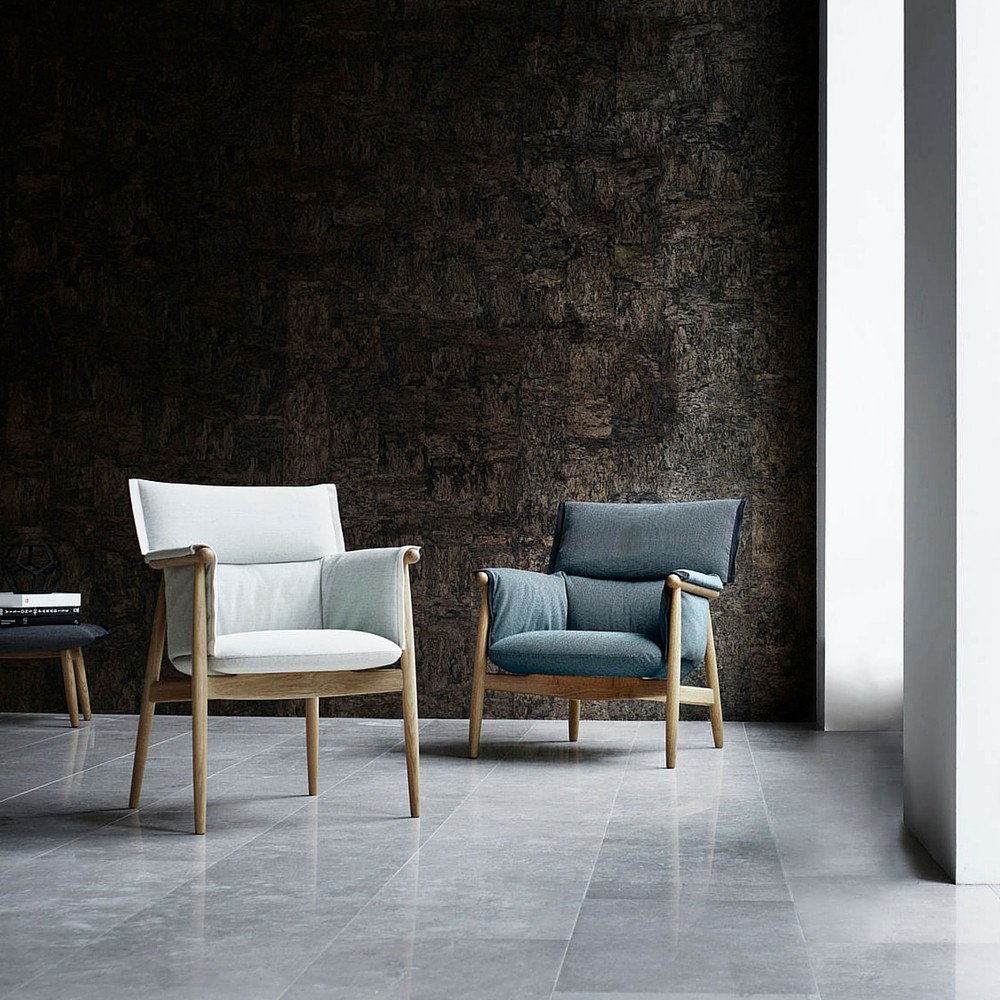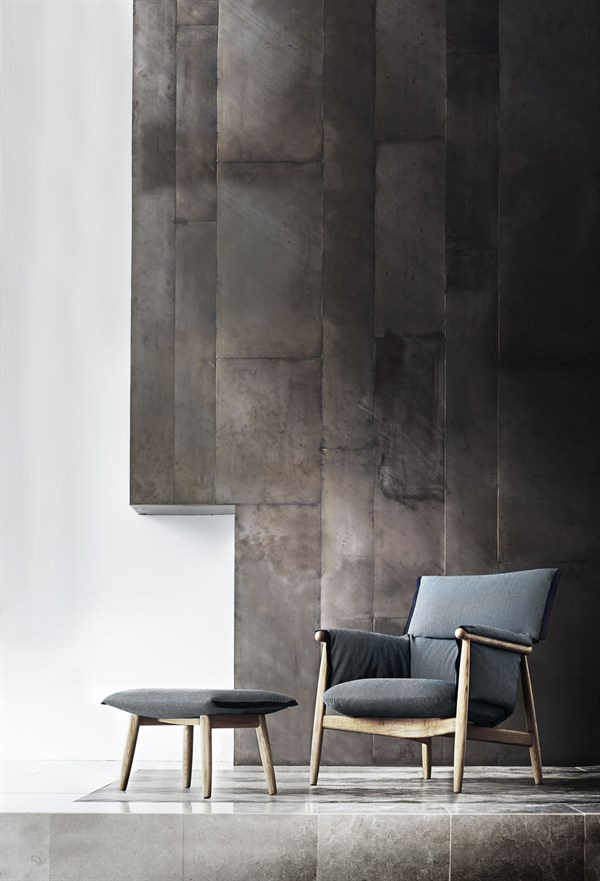
EOOS collaborates with Carl Hansen & Søn
EOOS collaborates with Carl Hansen & Søn
Share
Above image: EOOS partners, Gernot Bohmann, Martin Bergmann and Harald Gründl.
Carl Hansen & Søn is known for some of the most iconic and recognisable products in the world today. But the company is not content to rest on its laurels and has collaborated with celebrated Austrian architecture and design practice EOOS to produce a new range of chairs that sit perfectly with the heritage of the company. This new collection, called Embrace, complements the style and attitude of a Carl Hansen & Søn piece, but also stands alone in design and innovation.
While in Milan this year, inside co-editor Jan Henderson spoke with Knud Erik Hansen, managing director and CEO of Carl Hansen & Søn, and Gernot Bohmann and Martin Bergmann from EOOS about their collaboration and our changing world.
Jan Henderson: Have you been looking for a collaborator to work with Carl Hansen & Søn? And tell me about working with EOOS.
Knud Erik Hansen: We have, yes of course. We are very well-known for what we are doing and it was all done 50, 60, 70, up to 100 years ago, but we have beautiful [pieces of] furniture that can still sell because they are classical. But, our collaboration with EOOS was fun; we must have some fun! The most beautiful part is, we can work with somebody who is alive. I mean these two guys are very much alive, and therefore we can discuss the project. Here, at least, we get a dialogue, and it took us a long time but it’s fun.
And looking to the future?
KEH: Now we can develop, we can take the company further. And this is exactly what we are doing here. But what is important for us is that Embrace doesn’t look like anything else. You can do something that has a liking to the old masters, but be totally different.
And, you will be building on that series?
KEH: Yes. Now, we have the lounge chair, the dining chairs and perhaps a table soon. So, we will probably have a whole range from this.
Where did the idea for the furniture pieces come from? Did you feel the need to compromise your ideas to fit the Carl Hansen & Søn mould, Gernot?
Gernot Bohmann: It’s never a compromise for us because we are very interested to kind of feel the soul of a company, and to make something that is a combination of both identities of the company and us. So, we have to locate the overlapping area where we can say, ‘the design is EOOS’ and Carl Hansen & Søn can say ‘it’s Carl Hansen & Søn’, but it was hard and took several years. We had the idea, but you cannot make something like a Wegner in a short time or you will fail immediately.
So, Martin, how long did it take to develop Embrace?
Martin Bergmann: It took six to seven years in total, but two years of doing prototypes and models. It’s very important for us because, of course, we are drawing, but we immediately made one-to-one models to scale, ergonomic models, design models for proportions. Also, for the upholstery, we have a sewing machine, we test, we try to find the right fit of this folded upholstery, as inside it’s really loose, it’s like a jacket hanging on a wooden frame. It was difficult to get the idea and then to transform it for the company. We worked with a lot of prototypes and we learned and learned.
KEH: Yes, exactly. It looks so casual, but it isn’t. There’s actually a lot of work to get it to look like that.
Was sustainability something in your mind when you began the designing as well, Martin?
MB: Sustainability is part of Carl Hansen & Søn because of the handcrafted work. With the upholstery we thought we should do the minimum work, but maximise the comfort, not to create upholstery volumes. We came up with the idea of a thin, folded upholstery, and we think that’s a part of this thinking about reducing material, reducing foam.
GB: And, it’s also easy to repair, very easy to repair. After 30 years you need a new textile; it’s super easy to put on a new cover.
MB: You can change the cover, it’s not stapled, it’s not traditional upholstery. For us it’s a new combination of how we can handle upholstery and woodwork for Carl Hansen & Søn. But, the company itself is sustainable too. It’s not that we are sustainable designers, but it’s more the way of Carl Hansen & Søn.
A little about EOOS. When did the two, or actually three with Harald Gründl, come together?
MB: We met 27 years ago at the front of the University for Applied Arts in Vienna where we were waiting to sit an entrance examination. There was a row, and Gernot was in front of me and Harald was at the back. Over the years we studied together, did the diploma together and then we founded EOOS in Vienna immediately afterwards.
So Knud Erik, you’re collaborating with someone who’s not Danish?
KEH: I think that’s great, because Carl Hansen & Søn used to be a very Danish company. Now we are an international company, we have branches all over the world. We have more than 80 people outside Denmark employed by Carl Hansen & Søn taking care of our interests all over. And that means that I do not want to just limit us to Danes. There are some very good Danish architects, but there are many more outside Denmark. We are international; today the world is international. We are all moving. Some people are called refugees, but we must get used to it, we will mix up, we can fl y to the other side of the world in nine or 10 hours, so we can’t keep our borders anymore. We integrate, which is very healthy, culture and religion wise, and things like that, we have to. So, within the next 10 or 15 years I think the most important part for all of us is the environment, that we don’t kill each other with the smoke and exhaust fumes. I think, whether you are Austrian, Danish, Australian, whatever you are, you all have to unite and cultivate the products that don’t harm us.
So what’s next for you, Martin and Gernot?
MB: The next big thing for us is the Architecture Biennale as we are representing Austria in Venice. For us it’s not about architecture, it’s more about the big social problems. Our theme is Places for People. We have one big building in Vienna where about 400 or 500 refugees are living and waiting to get their visa or not get the visa; they are waiting there for six to eight months. They are sitting there, living there, 24 hours a day, doing nothing, just waiting. And their question was, of the government and of the Austrian curator, “How can design improve this situation?”, which was quite a hard task. So, we thought we can bring something to them where they can be active and they can communicate instead of just sitting in their rooms. The food is delivered and they just eat in their rooms. So we installed many kitchens with furniture where they can meet with big tables, benches and stools. It’s a kind of program that they can build on their own, so we installed a big workshop and the refugees build these things themselves. When you cook and eat together then communication is starting.
KEH: We have 16 refugees from Syria working in the factory now, and they’re excellent people. Some of them can already speak Danish and they have only been there for six months. They are so motivated, you wouldn’t believe it, and speaking Danish, which is a diffi cult language. And, you can have a little conversation with them, and they are so kind. We had one of the big Danish newspapers come to interview one of the guys and he said, “What are you doing?” in Danish, “What did you do before?” and the worker said, “I sold cars, I had my own big car shop.” (He sold Kia cars). So the journalist asked, “What have you got now?” and he said, “Me? I have the clothes I wear, nothing else. I have nothing. My family is sitting in Turkey. I have nothing, and I have my work, and I’m so happy. That’s all I have. I have nothing else to hold onto. The Government brings me money and things like that, but that will never last, but my work will last because I will do a good job.” It really touched me. He was fantastic.


















